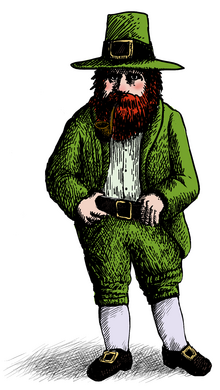Leprechaun
Leprechaun [ ˈlɛprəkɔːn ] ( Irish leipreachán, luprachán, lucharpán, lucharmán, lucharachán etc.), in German usage often simply goblin , is a creature of Irish mythology and belongs to the nature spirits that are often associated with the hidden gold at the end of the Rainbow. Alongside the harp, the leprechaun is one of Ireland's landmarks .
myth
As a folk figure, the leprechaun is one of the most famous fairy creatures in Ireland. He is of small, dwarfish stature and is only ever found alone. It is said that he bequeathed a pot of gold to the person who manages to coax the leprechaun into the secret of the place where the treasure is hidden. But this only works if you catch the creature by grabbing it by its shoulders and then not taking it out of your sight, as it can quickly disappear again. The background is the avarice of leprechauns. As a collector, he is very reluctant to give the gold and is therefore particularly tricky. However, in some stories he is also described as a helping house spirit . Even if he is often portrayed as grouchy, he should also be very generous, especially if you have helped him. Then he sometimes even gives away his magic gold coin, which, when it is spent, always returns to the owner's hand.
The leprechaun is often referred to as the shoe supplier or shoemaker of the fairies, which is why he is often depicted with a shoe that he manufactures or repairs.
Mostly he is depicted as a small, green dressed man with a hat and red hair.
Origins
It is believed that the leprechaun originated from the Irish legendary figure Lugh , who also appears as a shoemaker for the Túatha Dé Danann in the Lebor Gabála Érenn . It is also believed that he is a descendant of Ham , a cursed son of Noah , who came to the island in the early days of the colonization of Ireland.
etymology
It is believed that the name was formed from the Irish leipreachán in the 17th century . This is derived from the Middle Irish luchorpán (Middle Irish lu for “small” and corp for “body”) and alludes to the dwarfish growth of this mythical creature. Another interpretation uses the Gaelic stem * lukot- (Altir. Luch "mouse"), which also indicates its small size.
The alternative spelling leithbrágan is made up of folk etymology from the Irish words leith ("half") and brogan ("shoe"). This is likely due to the portrayal of the leprechaun as a shoemaker.
reception
Books
In Harry Potter and the Goblet of Fire , he appears as the mascot of the Irish Quidditch national team, here the term in German is rendered as "Leprechan". However, his gold is not real here - it disappears after a while and is ultimately worthless.
The Irish fantasy author Eoin Colfer explains in his novel series Artemis Fowl the name Leprechaun with the extension of the abbreviation LEP - Lower Elements Police (in the German translation ZUP - Central Underground Police) by the people, who henceforth referred to the fairy beings as Leprechauns.
Movies
The leprechaun also appears in a variety of films that deal with its various aspects. One of them, played by Gary Oldman , fulfills 60 wishes in the movie Interstate . An exaggerated allusion to the stinginess of this creature is the horror film series under the title Leprechaun - The Killer Goblin . Between 1993 and 2003 there were six more or less coherent films about the murderous leprechaun who goes after all those who dare to steal his gold. Warwick Davis was seen in the main role . In 2014, Leprechaun: Origins was released, a new edition of the horror film series. Leprechaun Returns from 2018 continues the first part of the series.
In the children's film Der Trollkönig (GB, 1998) a leprechaun plays a (main) role. The German title is a translation error. The original title is: The Last Leprechaun .
The best-known films in which leprechauns appeared are Henry Koster's The Luck of the Irish (1948) with Cecil Kellaway as the leprechaun (Kellaway received an Oscar nomination for his appearance), Robert Stevenson's The Secret of the Haunted Cave ( Darby O'Gill and the Little People , 1959), a Walt Disney production with countless leprechauns, and Francis Ford Coppola's musical Der goldene Regenbogen (original title: Finian's Rainbow from 1968). In addition, they often appear in series (as individual beings, but also in the majority), where, as with Charmed , they stand for luck (here they distribute happiness around the world using gold nuggets) or again form negative characters.
music
He also appears in numerous songs, for example the nursery rhyme Dear Jessie by Madonna or the song Deep Within by Within Temptation . Less often the whole song is about this legendary figure ( Leprechaun promenade of Dixie Dregs ) or even an entire album, as in the jazz-rock concept album The Leprechaun by Chick Corea .
mascot
The leprechaun is also often used as a mascot in real life, for example by the Boston Celtics , the football team at Notre Dame University or by the wrestler Dylan Postl alias "Hornswoggle". The use as a mascot underlines the lucky character of this fairy creature.
See also
literature
- Patricia Monaghan: The Encyclopedia of Celtic Mythology and Folklore. Facts on File, New York 2003, ISBN 0-8160-4524-0 .
- Bernhard Maier : Lexicon of Celtic Religion and Culture (= Kröner's pocket edition . Volume 466). Kröner, Stuttgart 1994, ISBN 3-520-46601-5 .
- Ranko Matasovic: Etymological Dictionary of Proto-Celtic . Brill Academic Pub, Boston 2009, ISBN 9-0041-7336-6 .
Individual evidence
- ↑ Monaghan, p. 92
- ↑ a b Maier, p. 205
- ^ Leprechaun , online entry in the Oxford English Dictionary
- ↑ Matasovic, p. 248 f.

